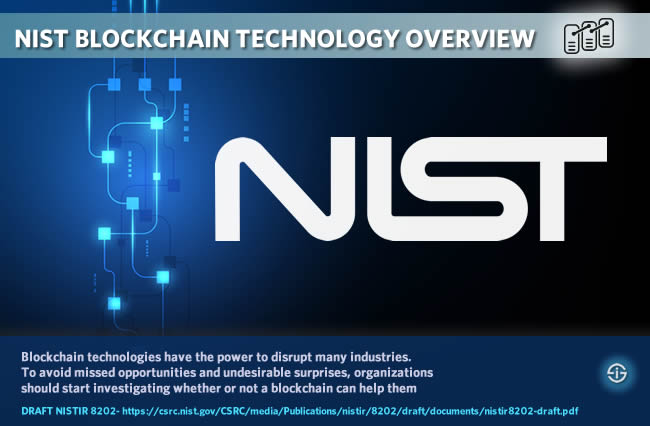The NIST blockchain technology report offers a more than comprehensive high-end overview of blockchain technology, blockchain system architecture components, blockchain use cases and the benefits and limitations of blockchain.
The NIST blockchain technology report mainly aims to serve IT managers who have little knowledge of blockchain technology and want to take informed decisions but goes beyond that.
In the corporate world, there’s always a push to adopt new technologies. Blockchain is today’s shiny new toy, and there’s a big push to adopt it because of that. We want to help people to see past the hype (PR Draft NIST Interagency Report (NISTIR) 8202: Blockchain Technology Overview, January 2018)
Blockchain technology gets ever more attention from business leaders, governments, organizations and businesses for their digital transformation efforts, mostly in combination with other technologies such as the Internet of Things, depending on the precise use case and domain. It’s a token of how serious blockchain technology is taken despite and beyond the current confusions and hype regarding blockchain with the major attention so far going to the more sensational stories regarding cryptocurrencies (where blockchain has its roots) and ICOs.
At the 2018 edition of the World Economic Forum, blockchain was omnipresent, again showing how it gets perceived as key for the future, although here as well there were many opinions regarding cryptocurrencies. The general attitude at Davos was ‘watch out for cryptocurrencies but do watch at the realities and possibilities of the digital ledger technology behind it, blockchain and DLT overall’.

Some blockchains or DLTs indeed show great promise while cryptocurrencies and ICOs are in the eye of a storm for all the wrong reasons (which doesn’t mean that cryptocurrencies have no future, well on the contrary) and some applications that leverage blockchains, especially smart contracts, are gaining broader interest as well.
The NIST blockchain technology report – scope
Blockchain and cryptocurrencies (again, not the same) have continued to attract media attention in 2018 as was the case in 2017, unfortunately as said often with loads of confusion and often for the wrong reasons. Fortunately there is also a lot of focus and, more importantly serious attention and initiatives from ‘serious’ instances, concerning blockchain.
After reports from, among others, the Cambridge Centre for Alternative Finance in September 2017, also NIST has joined the ranks of many reports and initiatives regarding blockchain. Keeping the future of cryptocurrencies aside for now, a quick peek at the publication of NIST on blockchain technology.
As a reminder: NIST stands for National Institute of Standards and Technology and is “a non-regulatory agency of the United States Department of Commerce with the mission to promote US innovation and industrial competitiveness”. In case that doesn’t ring a bell: NIST is behind a lot of work that has been done in the relatively early days of cloud computing, including offering definitions.
The use of blockchain technology is not a silver bullet, and there are issues that must be considered such as how to deal with malicious users, how controls are applied, and the limitations of any blockchain implementation. That said, blockchain technology is an important concept that will be a basis for many new solutions. (Draft NIST Interagency Report (NISTIR) 8202: Blockchain Technology Overview, January 2018)
The NIST Blockchain Technology Overview is still a draft as we write this (Draft NISTIR8202) and is open for comments through February 23, 2018. Moreover, the document aims to reach readers with limited or no knowledge about blockchain technology, seeking to understand it at a high level. To achieve that purpose some figures and tables, the authors write are “simplified”. Knowing that is the purpose and knowing the awareness regarding blockchain technologies and many use cases, DLTs and initiatives, the document has certainly achieved that purpose and far more.
Authors are Dylan Yaga (NIST), Peter Mell (NIST), Nik Roby (G2) and Karen Scarfone (Scarfone Cybersecurity) provide a great overview of what has been dubbed as, quoting from the NIST press release, “most disruptive technology since the internet”.
They don’t just offer an introduction to blockchain technology, the components of a blockchain system architecture, the need for consensus models, elements of the innovative data systems which blockchain is (such as hardforks), smart contracts, blockchain permission models and ample use cases, from financial ones to non-financial ones such as blockchain and IoT or applications in the scope of smart buildings (more below).
They also managed in covering some major benefits ad limitations of blockchain technology with the aim to, quote, “help IT managers make informed decisions about whether blockchain is the right tool for a given task”.
The NIST blockchain technology report and US lawmakers
Keeping the mission of NIST, as well as its past in mind, the NIST blockchain technology report is all the more interesting if we know that de facto it is not just meant for the described target audience but also can be seen as a document aiming to influence US government positions on blockchain technology.
Similar efforts have been done before in other countries and regions such as the UK and the EU and of course for particular industries where blockchain has the largest footprint (for the moment being banking/finance, government and insurance).
NIST already works with US lawmakers in the scope of blockchain. In the Summer of 2017, the Congressional Blockchain Caucus, which was founded end 2016 as an initiative of a group of lawmakers to push blockchain technology adoption in the US announced it was working with, among others NIST and MIT in order to look at security standards in the scope of blockchain.
Blockchain is a powerful new paradigm for business. People should use it—if it’s appropriate(Dylan Yaga, co-author Draft NIST Interagency Report (NISTIR) 8202: Blockchain Technology Overview, January 2018)
The announcement was done at the occasion of the launch of the DC Blockchain Center (with IBM among the founding partners), which among others aims to “help government agencies understand the potential benefits of blockchain technology and public sector use cases”. The DC Blockchain Center in turn is an initiative by the Chamber of Digital Commerce that has published several papers on blockchain before and also organizes several conferences. It consists of several ‘alliances’ such as the Smart Contracts Alliance which published papers on the subject, one with a foreword by ‘smart contracts inventor’ Nick Szabo who spoke at one of the events of the Chamber of Digital Commerce that has several leading blockchain companies, IT companies, banks, legal firms, financial institutions, consulting firms and so forth among its members and, among others has Don Tapscott in its Board of Advisors.
Tapscott and son Alex, as known wrote a book on blockchain and father Tapscott is a Senior Advisor of the World Economic Forum, which pretty much closes the circle of our intro about the omnipresence of blockchain at the edition 2018 of the event.
From cryptocurrencies to finance, supply chain and smart buildings
The NIST blockchain technology report also includes the roots of blockchain and expands on digital currencies and cryptocurrencies, covering their backgrounds, the reason why Bitcoin achieved what others didn’t and several cryptocurrencies which are often called ‘the next generation’ ones.
Among those: cryptocurrencies and blockchains bringing smart contracts more in the picture (think Ethereum) and others looking at cryptocurrency challenges such as interoperability (think the Cardano blockchain, launched on September 29, 2017 and not in the report yet).

Also other blockchain technologies are covered, however, and, as said, the NIST blockchain technology report dives deeper into essential blockchain concepts such as consensus (and the various consensus models such as Proof of stake and Proof of work), forking, smart contracts, blockchain categorization and use cases.
On the front of industries and applications mainly financial organizations, as mentioned the de facto largest industry for blockchain as it stands, are mentioned but there are ample other applications outside the world of finance, with among others blockchain in supply chain management, autonomous M2M transactions (blockchain and IoT) but also less known use cases such as smart buildings (in a scope of energy and smart contracts), as previously mentioned). So, there’s definitely also some attention for the future of blockchain – in practice.
Conclusion: the NIST blockchain technology report is a document to read. Despite the traditional disagreements with parts of it (such as the claim that Bitcoin Cash is mentioned as being the Original Bitcoin Chain and the absence of some things), which is food for discussions for the real insiders and those deeming these debates useful, which typically really don’t belong to the focus audience of the NIST blockchain technology report and businesses (in this case IT managers) seeking to understand blockchain for real-world applications.
More about “Draft NIST Interagency Report (NISTIR) 8202: Blockchain Technology Overview” (including the mentioned quotes):
Top image: Shutterstock – Copyright: Panuwatccn – NIST logo: File:NIST logo.svg– This image is in the public domain in the United States because it is a work of the United States Federal Government, specifically an employee of the National Institute of Standards and Technology, under the terms of Title 17, Chapter 1, Section 105 of the US Code. All other images belong to their mentioned owners.

